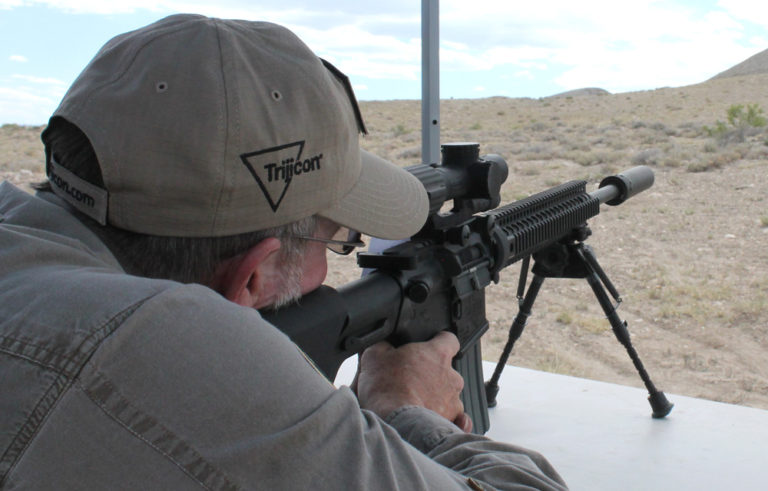
Hit targets at 500, 800 and 1,000-plus yards like they’re a chip shot with these must-know long-range accuracy tips.
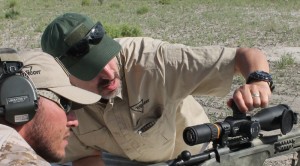
Perhaps no feat better epitomizes the marriage of precision firearms technology and marksmanship ability than long-range shooting. But it takes more than just a suitable caliber, a quality rifle, a top-shelf optic and a steady trigger finger. Every one of those components must work together like a finely tuned instrument in the hands of a skilled musician. Most importantly, for the long-distance shooter, consistently successful shots out to 500-plus yards can only be achieved through extensive practice in a variety of conditions and lots of homework.
“Long-range shooting is not just pulling the trigger, long-range shooting is about thinking,” says Tom Maciak, technology development engineering supervisor for Trijicon. Maciak recently showcased some of his company’s marquis products with dedicated long-range capability including the sniper-friendly 3-15×50 TARS (Tactical Advanced Riflescope) and the brand new 1-6×24 VCOG (Variable Combat Optical Gunsight). Before guiding our group in their practical application among the steep hillsides and open range of the Castle Valley Outdoors shooting and hunting resort in Emery, Utah, the longtime shooter and engineer summed up the 12 keys to successful long-range shooting.
1. Fit the Rifle to You
Ensuring the proper fit of a firearm to the shooter is more than just properly placing your head and eye behind the optic. More importantly, it’s about being able to control the rifle and establishing consistent attachment to the rifle every time the shooter brings it to his shoulder.
“The same thing has got to happen the same way every time you shoot the rifle,” says Maciak. For serious long-range shooting, you’ll want a rifle with a tactical stock that permits simple—and instant—adjustment to the length of pull and the cheek rest so the shooter can be completely comfortable. Take time to adjust the bipod or rest and any rear support of the buttstock before getting in position to shoot. Failing to do so will make it impossible to achieve a consistent weld to the gun and will increase the likelihood of scope shadowing, where the full visual diameter of the scope cannot be seen.
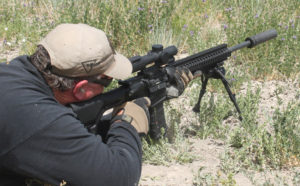
2. Adjust the Eyepiece/Ocular Diopter
A clear, focused reticle is critical for precise shot placement and is a very individual setting when viewed through different eyes. A good long distance scope will allow for this adjustment. Focus the reticle using the ocular adjustment while viewing it against a plain background such as a wall or the sky. Because the human eye will make adjustments to what it is focusing on itself, don’t look at the reticle while adjusting. Dial a quarter of a turn and look at and repeat the process until the reticle is clear and crisp.
3. Parallax
Parallax is the apparent movement of the reticle when viewing it at different, distance magnifications. At 9x and below, it’s not an issue. But for anything at 10x and above, if the reticle appears to wave inside the scope when viewed, parallax will need to be adjusted or it will affect your point of impact. To adjust, turn the parallax adjustment all the way out to infinity and bring it back in focus. The reticle should stop moving. Like focus, parallax may have to be adjusted at every distance.
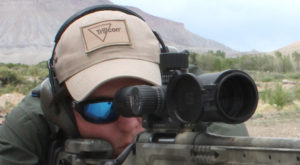
4. Reticle Illumination
If your scope has an illuminated reticle, a popular option in many high-end scopes these days, you do not want it on when using a reticle for ranging. Blooming, the affect created when viewing a lit object with the human eye, will thicken the size of the reticle and disrupt focus for proper ranging.
5. First or Second Focal Plane
When ranging a target using a ranging reticle, understand that first focal plane ranging will work at all magnifications. Second focal plane ranging only works at the highest magnification. How do you know which one you have? When adjusting magnification, if the reticle size adjusts with it, yours is in the first focal plane. If it doesn’t change size, it’s a second focal plane reticle. The first focal plane offers more flexibility, though you might have to dial down the magnification to find the target because full magnification creates a narrow field of view; it’s ultimately a personal preference. Between 2.5x to 10x, it probably isn’t a big deal which one your scope is.
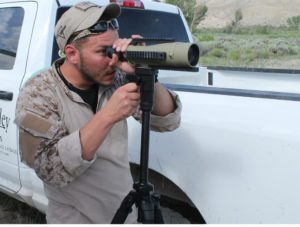
6. Place Your Body Behind the Scope
Watch most shooters and they will stand or position themselves behind the rifle at an angle. But all that recoil is transferred to your body, and if the mass of your body is largely to the side of that energy, it will jerk the body more. For long-range accuracy, square the body off behind the target to provide a more reliable base better able to accommodate recoil. It will help you stay on target throughout recoil for follow-up shots or to simply observe where your bullet strikes.
7. Ensure Reticle is Horizontal
Ballistics are made to operate with relation to a horizontal reticle, so if the scope is mounted improperly or not sitting on its rest so that the reticle is perfectly horizontal, make the necessary adjustments. An angled reticle can alter the relationship of your aim to the actual trajectory of the bullet and lead to missed shots at long distances.
8. Adjustment Dials and Come-Ups
This is where a shooter’s homework and knowledge of long-range ballistic performance is critical. First, you need to determine what increments or how much each click of adjustment of the scope will move your point of impact and whether that measurement is in MOA or mils. The farther you plan to shoot, the more adjustment will be needed in the elevation department so you need to ensure the scope has enough adjustment. (For a rough example, when shooting a .308 at a target 2,000 yards away, the bullet would have to be launched at an angle equivalent to a five-story building so that it would drop in and strike the target. That’s a lot of adjustment and for such shots, an angled base may be needed.)
You also need to understand dope sheets and come-ups or doping elevation, meaning you have to know how much your bullet will drop at the distances you will be shooting. Other aspects that must be factored in include the velocity of the load at various ranges, elevation where the shot will take place, the temperature, relative humidity, the difference between plain of the bore and the optic and then you need to be able to make accurate calculations for the particular bullet to be shot. “When you do your homework, it works well,” says Maciak. “Do your homework beforehand, and you don’t have to worry about that when it is time to make the shot.” He likes JBM Ballistics’ website at jbmballistics.com as a good resource for developing his data.
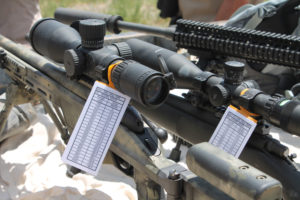
9. BDC Reticle
If the scope you are shooting has a BDC (Bullet Drop Compensating) reticle, the calculations are somewhat already done for you, but remember those reticles are made for a particular caliber or bullet at a specific elevation. They also tend to work on average loads rather than specific loads, so you will still need to shoot your specific load and determine the actual drop with relation to the reticle’s hash marks.
10. Wind
Entire books could be written on how to negotiate wind when shooting at distance so we’re not likely to nail it down in a paragraph or two. Suffice it to say, understanding a bullet’s performance in the wind is a true art form, and the only way to begin mastering it is to spend a lot of time shooting in the wind. Remember, wind where you are may be different than where the target is and can be influenced by the terrain the bullet must travel over. One trick is to use mirage, visible through a high-power optic to read the wind near the target and determine how far off to the side you must aim.
11. Shoot On the Bottom of Your Exhale
When you’re locked on a target and all dialed in, there is a rise and fall of your reticle from breathing and heartbeat. Remembering consistency is critical to shooting, if we shoot on the exhale, it gives us a consistent trigger time at a moment when the body is most relaxed. Hold that breath at the exhale for no more than three or four seconds and no longer. If you do, the body will start shaking because it’s technically becoming oxygen deprived. If you don’t make the shot, take another breath, and settle back in.
12. Trigger Follow-Through
Pull the trigger back and hold it. Don’t slap it; don’t lift your head off the stock. Keep it there long after the shot. You want to see the bullet impact the target through the scope, and holding the trigger prior to resetting it will help you retain sight of the target when you cycle the bolt for a second shot, which should be an automatic reflex when shooting a bolt-action rifle. You won’t have to reposition the scope and your body because they are pretty much the same. Keep in position until the shot strikes the target. “Remember, you’re not done shooting until the bullet hits target, which might be several seconds in long-range situations,” says Maciak.

Next Step: Get your FREE Printable Target Pack
Enhance your shooting precision with our 62 MOA Targets, perfect for rifles and handguns. Crafted in collaboration with Storm Tactical for accuracy and versatility.
Subscribe to the Gun Digest email newsletter and get your downloadable target pack sent straight to your inbox. Stay updated with the latest firearms info in the industry.

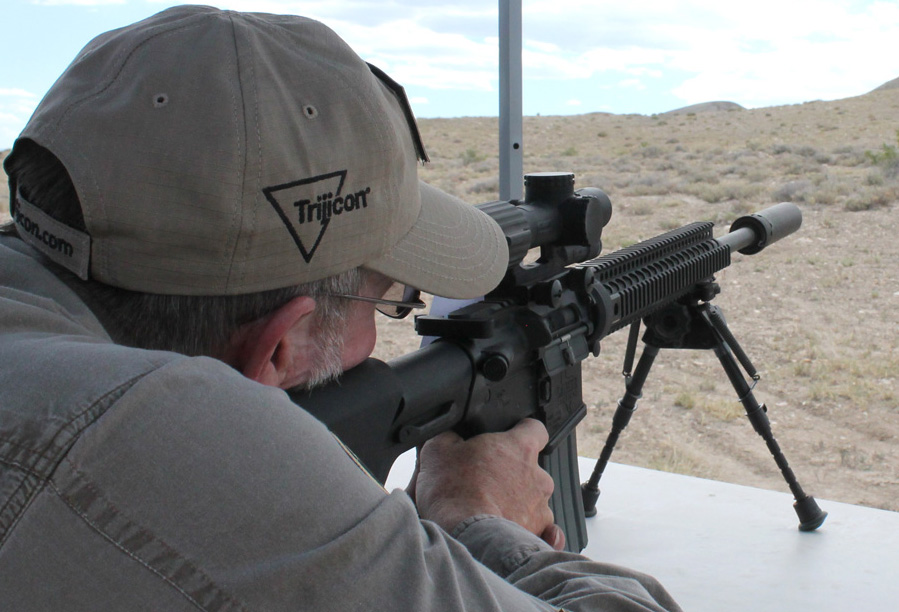
![Best Concealed Carry Guns In 2025 [Field Tested] Wilson Combat EDC X9S 1](https://gundigest.com/wp-content/uploads/Wilson-Combat-EDC-X9S-1-324x160.jpg)


![Best 9mm Carbine: Affordable PCCs [Tested] Ruger Carbine Shooting](https://gundigest.com/wp-content/uploads/Ruger-Carbine-Shooting-100x70.jpg)
![Best AR-15: Top Options Available Today [Field Tested] Harrington and Richardson PSA XM177E2 feature](https://gundigest.com/wp-content/uploads/Harrington-and-Richardson-PSA-XM177E2-feature-100x70.jpg)

# 5 is not totally true the writer said, he said ( Second focal plane ranging only works at the highest magnification)
there are many that don’t example , any nightforce that goes above 22x variable like the 42x all range at 22x other scopes that go above 24 or 25 example a 32 x might range at 24x